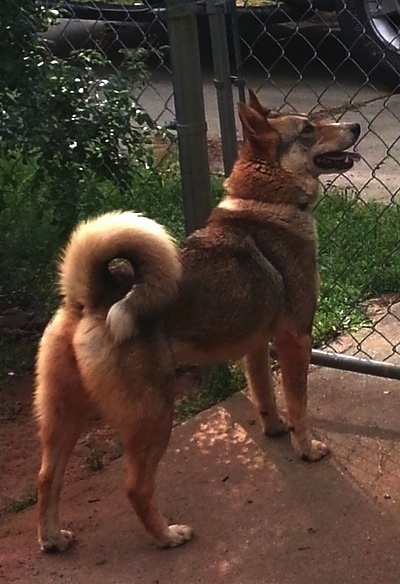
Courtesy of Glen Kansanback
West Si be ri an leik a
Most West Siberian Laika (WSL) are some shade of wolf gray, but there are pure white dogs and white dogs with colored patches. Some specimens have the coloration that matches a wolf or coyote almost perfectly, but all WSL have a curled tail carried up over the back, a trait that its wild cousins never have. Since this breed comes from a vast area of Siberia the gene pool is fairly large showing much genetic variation.
The West Siberian Laika (WSL) is a medium sized Nordic spitz type of hunting dog. This domestic breed of dog shares many primitive breed characteristics to his wild ancestors. For example, he has little to no "doggy" body odor, females comes into estrus usually only one time of year, generally has puppies in the spring, regurgitates food for puppies, is capable of digging a den in the earth for whelping puppies, and has extreme acute senses that are naturally used for hunting purposes. Although many specimens look wolfy in color pattern, this is not a wolf hybrid, but rather it is an established breed of dog developed in Russia. In the early 1900's the Russians made more effort to fix the individual breed characteristics of the breed and established an actual breed standard. However, with that said, the breed is always preserved to be a natural hunter of various quarry. The natural hunting instincts of the Laika is much different than most modern domestic breeds of hunting dogs. For example, most Laikas naturally look up into the tree canopy for animals, whereas this is a hunting trait that some modern hunting dogs never seem to learn. In Russia and more particularly in the Western Siberia region of Russia the West Siberian Laika is used on quarry that reside in the trees, such as squirrel and sable, which is similar to the North American pine marten. Once quarry is found in the tree the dog will naturally bark and follow the quarry from tree to tree. However any quarry chased on the ground is run silently until it is bayed up in a tree. If a squirrel is found feeding on the ground the WSL will try to catch it before it gets to a tree and if it is not caught the WSL will continue to chase it until treed, this chase on the ground is silent. Once the squirrel runs up the tree to escape the hot pursuit, the WSL will then give voice. This is different to many modern hound type of dogs that give voice as soon as scent is detected. The WSL has desire to catch small quarry on the ground if he can. The tenacity of the WSL on dangerous quarry is well known and is considered a paramont Russian grizzly bear or bore hunter. However, due to his natural primitive hunting instincts and ability to survive these dogs just do not charge into dangerous quarry and get hurt. The WSL is not a catch dog, but a bay dog and once the quarry is found he is run until bayed up in a tree or cornered on the ground. Giving no voice while running, but opening up to continous barking once the quarry is cornered or treed. These dogs also bay moose for the hunter to come in to take the shot. The term laika means a dog that barks, or a barking dog. In North America the WSL is currently hunting feral hogs, bear, cougar, bobcat, raccoon, opossum, squirrel, etc. This is a paramount squirrel hunting dog. Many North American hunters have come to realize that this primitive aboriginal hunting breed from Russia is so natural at hunting squirrel that all one really has to do is take him to the woods so that he can learn to use his instincts of which he has imbeded in his DNA. Simply put, the instinct to hunt is already there, all they have to do is be given an opportunity to learn how to use them. The training aspect can involve teaching him how to load into a vehicle, travel in a kennel, or responding with the hunter while in the woods; however one does not really train these dogs to hunt they just do it. In fact this is what they do first and foremost: food, and companionship to the human master comes secondly to the hunting instincts that these dogs have. One can prevent the dog from hunting by keeping him in a pen, but one can never remove the natural instinct to hunt once the dog is loose in the woods. The WSL is an adaptable breed and several of them are currently living in the hot humid south as well as the hot desert southwest. They develop a thin summer warm weather coat when kept in the hot climates. The WSL is extremely quick, agile and flexible. Being a dog from the Northern Boreal (Taiga) forest, this athletic dog can run through the timber just like a coyote or a wolf, very quick while pursuing quarry. One has to really see this athletic ability to believe it. They are a northern spitz type dog it does look similar to the sled dogs of the north such as the Siberian Husky, however the WSL has been the hunting version of the Siberian dogs. The breed does not have the natural get along with larger groups of dogs as its sled dog counter part, and in many cases it may even be somewhat aggressive to members of the same sex. Males or females that are expected to hunt together generally have to be raised together from pups, and even then some dogs may be prone to dog aggression. The WSL Laika do best when housed or hunted alone, or in male female pairs. Most WSL in the States are used for hunting purposes or for outdoor companions such as for backpacking. The West Siberian Laika is a loyal companion who bonds very closely with his family, however he is not a lap dog content on being inactive. Having extremely developed senses, they are always alert and totally in tune to their surroundings at all times. Thus, they make very good watch dogs as nothing really gets by them. To some people they would appear to be hyper active, as the WSL are always attentive to everything. This activity should not be confused with nervous energy that some high strung dogs have. WSL can be protective of property and his master against dangerous animals such as bear or stray dogs. Some dogs may be protective against strange people however that is not overly common within the breed. These dogs may appear to be aloof, but to those who know them well know they are just independent thinkers. As a breed showing primitive characteristics being great hunters in the vast wilds of Western Siberia they are able to engage with dangerous quarry without getting hurt. They hunt with their masters, but for the hunt itself they are expected to react on their own to the unfolding hunting situation without waiting for assistance or direction from their master. They do this so they do not get injured and so that they can also be successful in the field. The WSL is very good at problem solving and have the ability to remember situations very well. In the home environment they are very affectionate and enjoy their human companions, but again, they are not simple lap dogs. They are good with children, and most other pets including other domestic farm type animals. However, chickens and rabbits sometimes are just too tempting to some dogs so good cages are required. The WSL are often aggressive to stray dogs that come onto the property, but generally will accept other dogs it is raised with. Same sex gender aggression is not uncommon within this breed. The WSL does not take well to a rough hand, or loud yelling type of voice. If young pups are not handled or socialized properly they can become timid and aloof towards humans so early socialization is very important. If not properly socialized a puppy may never develop into a trusting loving companion. If socialized properly they are as tame and affectionate as other modern breeds of dogs. Some dogs will bond so tightly to its master that they do not do well in transferring to someone else once mature, and even after years of separation will remember their "first love" if reunited. As far as hunting companions go, once mature these dogs may not hunt well with strangers being present or transfer well to knew homes if the new owner does not satisfy their instincts. These are not community property type of dogs, because they do bond with their family pack very tightly. With that said, they do not do well sitting in a kennel situation or tied to a tree without regular interaction with their family due to the depth of bonding that developes.
Height: Male 22 - 24 inches (56 - 61 cm) Female 21 - 23 inches (53 - 58 cm)
Weight: Male 35 - 50 pounds (16 - 23 kg) Female 30 - 45 pounds (14 - 20 kg)
There are variences to these size ranges.
The WSL has no known genetic health problems that have been fixated on the breed. The reason for this is because the breed has not been inbred to fix specific showroom characteristics to please bench-show judges. However, this is a concern with many hunters who hear that more and more of these dogs are making their way into modern bench-shows. With the breed being primarily maintained as a hunting breed from West Siberia only healthy proven strong dogs were kept and bred thus genetic diseases have not developed as in other breeds that are bred primarily for show purposes. Inbreeding techniques have not allowed inferior recessive gene traits to become fixated within the breed. As with all dogs, the WSL can catch any canine diseases and parasites, but as far as hereditary diseases most hunting lines of this breed is still genetically healthy. Here in the United States, although our gene pool is small, most hunters are not inbreeding their dogs and this is a practice that is critical to keep the breed genetically healthy. Most hunters are aware of this and are willing to help keep the gene pool healthy.
This is not an apartment dwelling breed of dog. It is active and loves to explore its world, and a bored Laika is a Laika who is going to get into trouble in one way or the other to occupy its active mind. A home with at least a fenced yard is required, but a home with some acreage is best. As a puppy the WSL can be destructive, and as a bored adult can be equally as destructive. Being a Siberian dog, no cold is too cold for this breed as long as he has protection from the elements such as a good doghouse. Once acclimated, this breed can tolerate the hot climates better than other Laika breeds such as the Karelian Bear Dog. The WSL does require more than average water during the hot summer.
The West Siberian Laika needs lots of exercise, which includes a daily, long, brisk walk. Will do best with a large fenced in yard.
14+ years
About 6 to 10 puppies
This breed has a double coat and does shed a lot during the seasonal molt. However, once molted out and brushed he is manageable not much different than a German Shepherd or other dogs with double coats that shed. One important aspect to consider is that the WSL does not have natural dog body odor as with most modern breeds. A clean WSL even when wet does not smell "doggy". It will develop a warm climate coat once adapted to the warmth. The WSL is a naturally clean natured dog. Outside of seasonal shedding the breed is a clean companion. Its coat has the ability to naturally shed off dirt due to not having an oily coat as some modern dogs have.
The West Siberian Laika has hunted with mankind going back to pre-history records. It is an aboriginal primitive hunting breed that shares many characteristics to its ancestor the wolf, however being in the hands of mankind for countless generations it is a domestic breed of dog. There are other Laika breeds, but the West Siberian Laika hunted mostly with the Hanty and Mansi cultures of West Siberia and Ural Mountain regions of Russia. The WSL is not the same Siberian dog that was used for pulling sleds. The WSL was used for hunting in the zone below the tree free tundra zone where the northern boreal (taiga) forest begins, and the forested areas of the Ural mountains. To help visualize the taiga zone compare it to the thin zone of taiga in the continental United States in Northern Minnesota, Michigan, and Wisconsin which would be considered taiga. Canada has much of this zone in its country, too. These dogs are adapted for woodland hunting habitats, and were used in some areas for the much valuable sable fur industry. The sable was nearly hunted to extinction, and when this premier quarry crashed in numbers so did the Laika in some areas that hunted them. In the early 1900s efforts were used to save the Laika and a more developed breed standard was incorporated around the 1930's. Today the West Siberian Laika is still used extensively as a hunting companion. The West Siberian Laika was first imported into the United States in 1992, by Mr. Vladimir Beregovoy, PhD an immigrant from Russia. If it had not been for his enthusiasm for this breed of dog it may have never found its way to the USA. As of 2014, it is estimated that approximately 21 individual dogs have been imported into the USA with an estimated population of 300 dogs.
Northern Spits/ Nordic
Information courtesy of Glen Kansanback
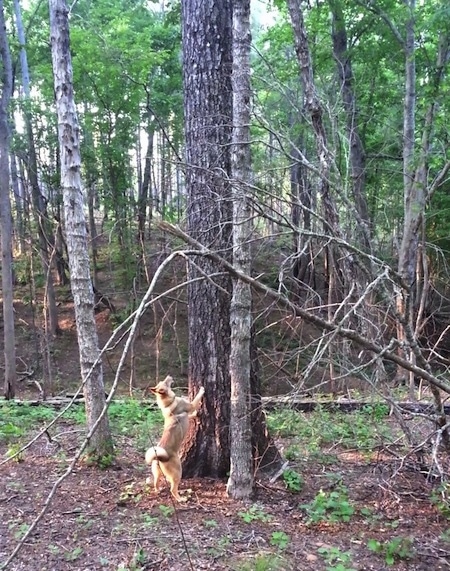
Female West Siberian Laika treeing—Courtesy of Glen Kansanback

Taiga the West Siberian Laika from Estonia—"Taiga is a 4-year-old purebred West Siberian Laika. As her last owners had a child, they gave her up to a dog shelter. We adopted her a few months ago. Although she had trust issues at the beginning, she is adapting very well."

Taiga the West Siberian Laika from Estonia

Taiga the West Siberian Laika from Estonia with her Laika friend in the snow
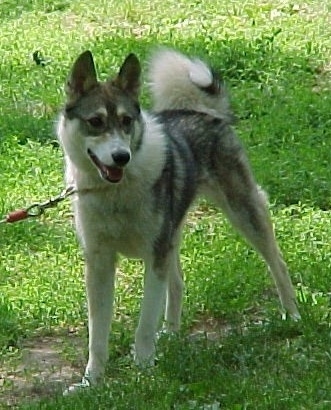
"This is Chevy (aka Laika Rock), a West Siberian Laika in the backyard before I brought her home. Chevy is an intense dog; she hyper-focuses on EVERYTHING she does! She hunts squirrel and coon, and even has a bobcat to her name (and strictly hers... she didn't wait on her hunter to help her out!) But she is so much fun, faithful and adorable."

Siberian Laikas Spunky and Lady are excellent squirrel dogs.

Rey the West Siberian Laika from the Ukraine
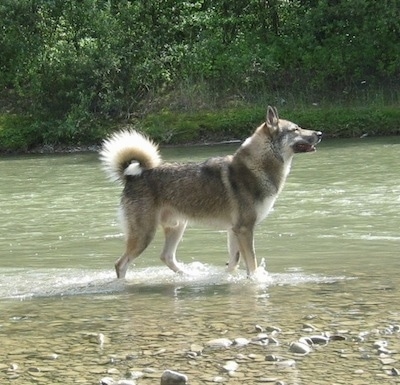
Rey the West Siberian Laika from the Ukraine
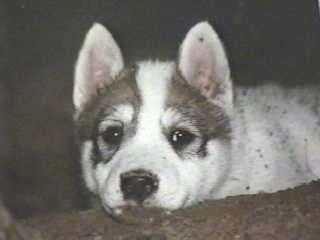
West Siberian Laika puppy, photos courtesy of Shelma Pack Kennel

West Siberian Laika puppies, photos courtesy of Shelma Pack Kennel